Karst
![]()
The title of this article is ambiguous. For other meanings, see Karst (disambiguation).
In geology and geomorphology, karst refers to underground terrain forms (karst caves) and surface terrain forms (surface karst) in carbonate rocks (also in sulphate rocks, salt rocks and sandstones/quartzites), which have predominantly been formed by solution and carbonic acid weathering as well as precipitation of biogenic limestones and similar sediments with high contents of calcium carbonate (CaCO3). The main feature is the predominantly subterranean water balance, which is not based on a primary porosity of the rock, but secondarily and in geological time on a corrosion of the rock, the karstification.
On a large scale, karst is found around the Mediterranean Sea as well as in Southeast Asia and South China, the Greater Antilles and the Indo-Australian Archipelago, on a smaller scale in the German low mountain ranges (Swabian Alb, Franconian Alb), the French and Swiss Jura, other parts of the Northern and Southern Alps as well as in Western Europe in general.
In terms of human geography, there is a particular difference in the use of natural areas in the karst landscapes of the Mediterranean region (= Mediterran) and Southeast and East Asia. Herding livestock and seasonally adapted semi-nomadic herding animal migration have been widespread in the karst mountains of the Mediterran since antiquity, but corresponding use of karst plateaus outside the Mediterran is scarce; It is often held responsible for their greater degradation and deforestation with subsequent damage to the ground cover, but postglacial faunas with high proportions of alpine-adapted animal species on low-lying karst plateaus indicate that even in the most highly developed Mediterranean karst landscape of the Dinarides today, no postglacial development to forest landscapes took place. Diametrically in terms of cultural topology, a more differentiated agro-economic form of economy with small animal husbandry and irrigated agriculture is established in tropical karst countries.
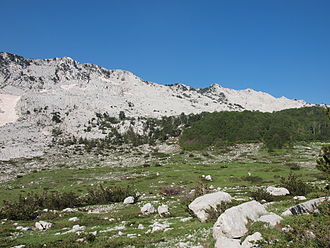
Glaziokarst landscape, Orjen (Montenegro)

Karst waterfalls and lake landscape: Plitvice Lakes National Park (Croatia)
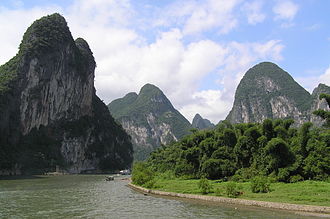
Tower karst landscape, Guilin (China)
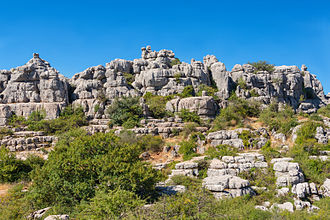
Karst in El Torcal de Antequera, Andalusia (Spain)
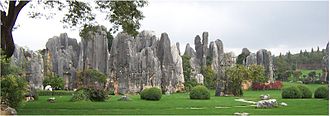
Pinnacle karst landscape, Shilin (China)
General
Deeply developed karst landscapes can have completely dry soils despite abundant and sometimes high precipitation. Karst landscapes are subject to an age-related erosion cycle. In principle, this is caused by stronger corrosion and erosion under humid-tropical climatic conditions. Tropical and extratropical karst forms are distinguishable, as well as geomorphologically fully developed karst (holokarst) and less developed karst (merokarst). Karstification and erosion of the karst relief are part of a global biogeochemical material and geological rock cycle; specifically, the carbonate-silicate cycle is directly related to the carbon cycle through biogenic and geological processes that are the result of the evolution of life. Carbonates (calcite CaCO3 and dolomite CaMg(CO3)2) are also the largest carbon reservoirs on Earth.
Etymology of the terms
The Karst landscape, which lies halfway between Lubljana and Trieste on the southeastern edge of the Alps, is considered to be the type locality and thus the eponym of the Karst geological phenomenon.
In this significant karst landscape, where the largest karst lake (seepage lake) in the world is located, the Cerkniško jezero (German: Zirknitzer See), the phenomenon of karst was researched in detail for the first time.
The results of research by scientists of the Habsburg Monarchy, such as Marko Vincenc Lipold, Dionýs Štúr and Guido Stache, were published in German and therefore the German name Karst became internationally accepted.
The term karst and all its similar-sounding names in other languages derive from Latin carsus with the word root *kar- meaning 'stone, rock' (cf. Slovenian kras, Croatian krš, Serbian Cyrillic крш, Italian carso, Latin carsus 'stony and barren ground'; Indo-European most likely*kar- 'stone, rock').
Only in the wake of the first standard work Morphology of the Earth's Surface (Albrecht Penck, 1884) and especially through the work of the first karstologist Jovan Cvijić did geomorphology establish itself as an independent science. In the process, the local names of karst forms of the Dinaric countries were generalized from Slovenian, Croatian and Serbian for the German and French technical language (so dolina, polje, ponor, hum).
With the exploration of tropical karst areas in the Caribbean and Southeast Asia, the range of terms expanded (for example, the Spanish terms mogote and cenote and the English term cockpit). Thus, karst terminology today uses a variety of terms from different languages. Due to the historical development of karst research, some terms used in English differ from those used in Central Europe.
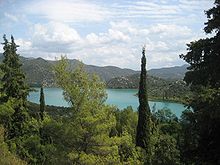
Karst Lake Landscape Baćina Lakes near Ploče in the South of Croatia
Questions and Answers
Q: What is Karst?
A: Karst is a geological system of rocks where water has eroded (dissolved) the bedrock. It is classed as a badland if it difficult to travel through the environment, which it often is. Almost always, karst is formed in carbonate rocks, such as limestone or dolomite.
Q: Where does Karst occur?
A: Since carbonate sedimentary rocks are very common, karst areas occur all over the world.
Q: What are some surface features associated with Karst?
A: Many karst regions display distinctive surface features, with sinkholes being the most common. However, karst surface features may be absent where the soluble rock is mantled (covered), such as by a non-soluble rock strata on top of the carbonate strata.
Q: Are there caves associated with Karsts?
A: Yes, some karst regions include thousands of caves and the water is generally underground.
Q: What is an example of a large Karstic area?
A: The world's largest karstic area is the Nullarbor Plain in southern Australia which occupies an area of about 200,000 square kilometres (77,000 sq mi). At its widest point it stretches about 1,100 kilometres (684 mi) from east to west across the border region between South Australia and Western Australia.
Q: Is Nullabor Plain treeless?
A: Yes, Nullabor Plain is flat and almost treeless dry country.
Search within the encyclopedia